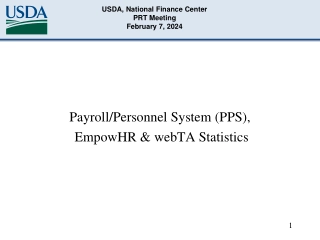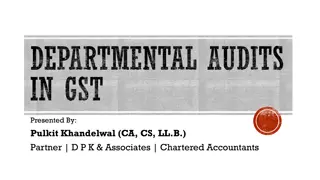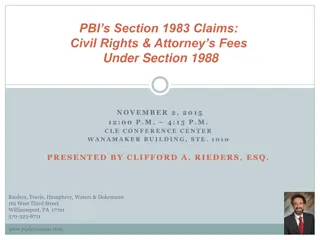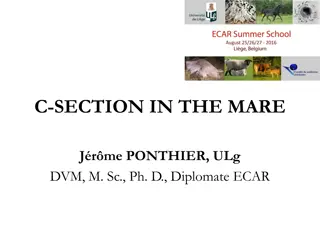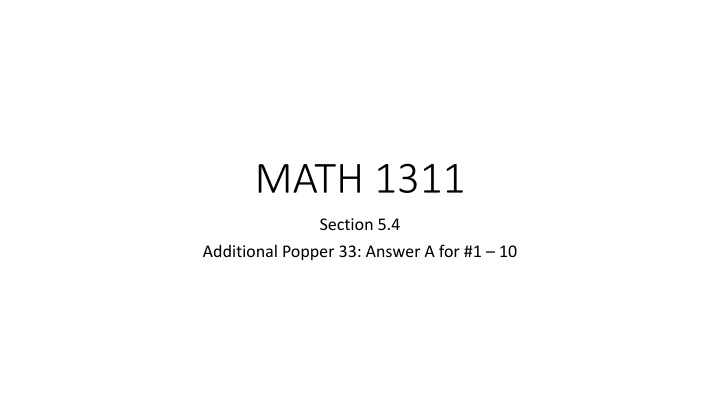
Combining Functions in Mathematical Examples
Explore examples of combining functions involving limiting values, exponential functions, and initial differences in temperature settings, using mathematical concepts to determine temperature variations over time.
Download Presentation

Please find below an Image/Link to download the presentation.
The content on the website is provided AS IS for your information and personal use only. It may not be sold, licensed, or shared on other websites without obtaining consent from the author. If you encounter any issues during the download, it is possible that the publisher has removed the file from their server.
You are allowed to download the files provided on this website for personal or commercial use, subject to the condition that they are used lawfully. All files are the property of their respective owners.
The content on the website is provided AS IS for your information and personal use only. It may not be sold, licensed, or shared on other websites without obtaining consent from the author.
E N D
Presentation Transcript
MATH 1311 Section 5.4 Additional Popper 33: Answer A for #1 10
Combining Functions There are times when different functions can be combined based on their individual properties. Very often, this will involve a limiting value (given as a linear component to a function) and an exponential or power function to represent the difference to that limit.
Example: You place a cup of coffee, at an initial temperature of 110 degrees, in a room with a constant temperature of 75 degrees. After 2 minutes, the temperature is 95 degrees. What is the limiting value of this situation? What is the initial temperature? What is the initial difference between these?
Example: You place a cup of coffee, at an initial temperature of 110 degrees, in a room with a constant temperature of 75 degrees. After 2 minutes, the temperature is 95 degrees. What is the limiting value of this situation? 75 degrees (the temperature of the room) What is the initial temperature? 110 degrees (the starting temperature) What is the initial difference between these? 110 75 = 35
Example: You place a cup of coffee, at an initial temperature of 110 degrees, in a room with a constant temperature of 75 degrees. After 2 minutes, the temperature is 95 degrees. The temperature of the coffee will be represented by the: C = Limiting Value Temperature Difference Since the limiting value is less than the initial temperature, we will use add the temperature difference. C = 75 + Temp Diff
Example: You place a cup of coffee, at an initial temperature of 110 degrees, in a room with a constant temperature of 75 degrees. After 2 minutes, the temperature is 95 degrees. Temperature difference is usually modelled by an exponential function. D = a bt The initial difference in temperature is 35 degrees, so that will become the a-value. D = 35 bt
Example: You place a cup of coffee, at an initial temperature of 110 degrees, in a room with a constant temperature of 75 degrees. After 2 minutes, the temperature is 95 degrees. D = 35 bt After 2 minutes, the temperature difference to the limiting value is 20 degrees, so we can use: 20 = 35 b2 and solve for the b-value.
Example: You place a cup of coffee, at an initial temperature of 110 degrees, in a room with a constant temperature of 75 degrees. After 2 minutes, the temperature is 95 degrees. D = 35 bt After 2 minutes, the temperature difference to the limiting value is 20 degrees, so we can use: 20 = 35 b2 and solve for the b-value. So D = 35 (0.756)t b = 0.756
Example: You place a cup of coffee, at an initial temperature of 110 degrees, in a room with a constant temperature of 75 degrees. After 2 minutes, the temperature is 95 degrees. The final formula is: C = 75 + 35 (0.756)t Use this formula to estimate how many minutes it will take for the coffee to be 80 degrees.
Composition of Functions: Composition of functions occurs when one function is applied to another. This is done by substituting one formula for the independent variable in another formula.
Example: The fuel consumption of a car is given by g = d/35where g is measured in gallons of gasoline and d is measured in miles. A car, at a constant speed of 65 miles per hour, travels a distance given by the formula d = 65t where t is measured in hours and d is measured in miles. Write a formula that will give the fuel consumption of a car, driving at a constant speed of 65 miles per hour, in terms of time travelled.
Another Example: The weight, in pounds, of children can be defined in terms of their height, in inches, by the formula: w(h) = 4.4h 150. The height of children can be estimated by their age, in years, according to the function: h(t) = 1.9t + 40. Create a formula that will relate a child s weight to that child s age. The use that formula to find the approximate weight of a child at an age of 12 years.
Piecewise Functions: A piecewise function is a function that changes depending on the value of the independent variable. Example: it may look like a line for values less than 5 but an exponential graph for values greater than 5. For these, you have to create a list of functions and criteria: ? ? = ????????1,? < ? ????????2,? ? Keep in mind, no x-value should belong in two different categories.
Example: Water usage is charged at a flat rate of $35 for the first 5000 gallons used in the month, and then $.01 extra for every additional gallon used. If we are to write a formula for w(x), at what value would that formula switch from one function to the other? What would it look like before this switch? What would it look like after?
Example: Water usage is charged at a flat rate of $35 for the first 5000 gallons used in the month, and then $0.01 extra for every additional gallon used. If we are to write a formula for w(x), at what value would that formula switch from one function to the other? 5000 gallons What would it look like before this switch? 35 What would it look like after? 35 + 0.01(x 5000) = 0.01x 15 35,? 5000 0.01? 15,? > 5000 ? ? =
Example: Water usage is charged at a flat rate of $35 for the first 5000 gallons used in the month, and then $0.01 extra for every additional gallon used. 35,? 5000 0.01? 15,? > 5000 ? ? = Use this to find the monthly bill for having used: (a) 2500 gallons, (b) 5000 gallons, (c) 6500 gallons.
Popper 30 The dosage of a certain medication varies according to patient s weight. For a patient under 150 pounds, 25 mg of medication should be administered. For patients 150 pounds through 250 pounds, the dosage should increase by 1 mg for every 10 pounds of weight. For patients over 250 pounds, the dosage should be 35 mg. 1. What conditions are used to break apart the function? a. age b. weight 2. What function should be used for 150 w 250? a. .1x 150 b. .1x + 10 3. What would the dosage be for a patient weighing 100 pounds? a. 25 b. 20 c. 35 4. What would the dosage be for a patient weighing 200 pounds? a. 25 b. 30 c. 35 c. dosage d. height c. 150x + 10 d. .1x 150 d. 45 d. 45

